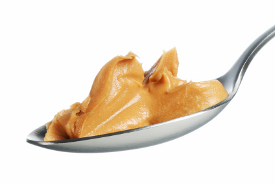Add Peanut Butter to Your Diet the Right Way

Peanut butter and jelly go hand in hand, everyone knows that. But did you know peanut butter is good for you and has weight loss benefits? Before you start using peanut butter, understand that the type of peanut butter you use in your diet does make a difference.
Regular peanut butter contains additives, preservatives, salt and added sugar. If you read the label, most will say that regular peanut butter contains no trans fats even though it does have it.
When you look at the label, you’ll see that it has ‘partially hydrogenated oil’ listed. How can these peanut butters list no trans fat when it’s an ingredient? The FDA allows it because it’s less than a certain amount.
What’s the big deal with trans fats? They increase your risk of developing heart disease. These types of fats begin as a liquid but are changed to a solid form within the peanut butter. Go Natural But natural peanut butter doesn’t have any of the preservatives or additives. The ingredients listed on one brand of natural peanut butter are peanuts and salt. When you open a jar of natural peanut butter, you’ll see liquid oil floating on the top, while it might look odd, this isn’t bad for you in the least bit.
See: The Secret Link Between Food and Success
Some people are so used to the appearance of the regular kind of peanut butter that after they switch to natural and see the oil separated, at first, they think they’ve purchased a bad jar of peanut butter.
Hearth Healthy and Helps to Keep You Full Peanut butter is around 75% - 80% unsaturated fats, which is good for your heart. (That percentage is about the same as olive oil.) It also contains vitamins and minerals, including vitamin E and potassium—and even a bit of fiber.
Not only is it heart healthy, but the protein and fat in peanut butter will help keep you feeling full—always a plus when you’re trying to lose weight.
Smart Ways to Add Peanut Butter to Your Diet Unlike years ago, you don’t have to stick to eating peanut butter in a PB & J sandwich. You can add peanut butter to your daily diet in several ways other than the way you remember eating it growing up.
Most fruit tastes delicious with natural peanut butter. Not only is peanut butter great spread on apple slices, but bananas and peanut butter go hand in hand as well. For breakfast, you can mix a little peanut butter in with your oatmeal. If oatmeal isn’t something you prefer, you can spread it on a slice of whole wheat toast or top a plain whole wheat bagel or English muffin with a spoonful of peanut butter.
See: Grains for Weight Loss: Are They Good or Bad?
As a snack, you can put natural peanut butter on crackers. For the best crackers if you’re trying to lose weight, choose a low calorie/high fiber cracker made from wheat. You can put peanut butter on a warm tortilla and add a sprinkle of raisins. For a main dish, peanut butter can be added to homemade (sugar-free) barbecue sauce as a marinade for chicken.
Don’t Go Too Nutty Though However you decide to add peanut butter to your diet, make sure you don’t take it to the extreme. Get out the measuring spoon and measure out a 1 tablespoon serving (approximately 90 calories). Like any food, peanut butter is best used in conjunction with weight loss when you practice portion control.
Must Read
6 Satisfying Foods That Won’t Leave You Hungry
Healthy Snacks Can Help You Lose Weight
How to Add Dairy to Your Diet
